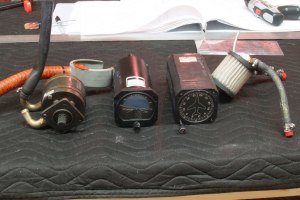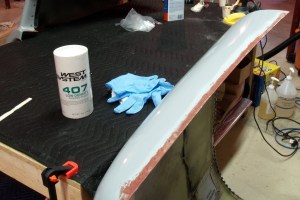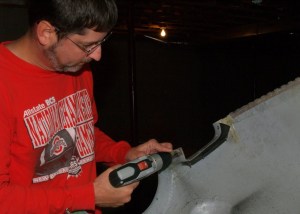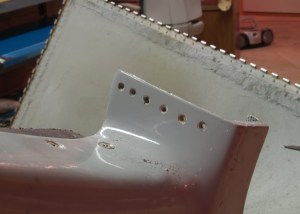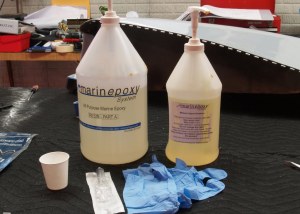… “I made a lot of progress today! I was going so fast that I almost passed a snail trapped in a puddle of molasses!”
Well, it seems that way. I started this oil change on November 8th and as I sit here in the quiet solitude of December 23rd, enjoying the last smidgen of calm before the holiday storm, I can reflect back on the intervening days and weeks and honestly wonder just why this is taking so daggone long. What it comes down to is a series of distractions combined with unforeseen delaying events. Distractions arising from holiday preparations and the seductive Siren call of the RV-12 project have certainly played a role, but the fiasco of the broken Subaru has played a part as well. And, truth be told, there was a bit of decision making to be done too.
As it stands today, the Subaru is repaired, the cowls are repaired, albeit without the final finishing step of applying paint to the repaired areas, and the decision has been made regarding how (and keep in mind that ‘if’ was a player as well) to replace the faulty attitude indicator.
The Subaru needed a new head gasket, but for a couple of reasons actually received two new head gaskets, a new timing belt, new spark plugs, and a new thermostat for the radiator. Plus fluids. Those aren’t exactly cheap either, you know. Geographical challenges and some minor maintenance delays stretched the job out for a couple of weeks, but it’s all done now and other than a lingering scent of baked antifreeze, everything seems to be working just fine. The car has over 80,000 miles on it and this is the first real maintenance it has needed, so I can’t really complain.
The cowls are primered on the affected areas, but final painting will have to wait for the more conducive temperatures of Spring for final painting. Having been once burned, though, I’m naturally twice shy on the topic of hauling them out to my brother for painting. A pretty clear Karmic message has been sent: perhaps I should bite the bullet and learn how to operate the painting equipment I own. I have an air compressor and a Harbor Freight HVLP spray gun – I ought to see if I can learn how to use it.
In the meanwhile, I bought myself some time on the issue of the attitude indicator by removing the vacuum pump. Following my inimitable method of making big decisions (which is to muddle about making small decisions until I have painted myself into a corner), I spent quite a bit of time working with my mechanic to make sure every delaying tactic was both safe and useless.
The decision to be made was, of course, whether to replace the broken vacuum-powered, mechanical attitude gyro with a similar item, thereby running the risk of breaking another $700 gyro, or to upgrade to a solid state electronic model and slightly more than twice the cost. The higher cost option would normally have been the obvious solution because of the improved reliability combined with equally improved utility, but I can’t help spicing up the decision making process by adding in the question of how long I will own this plane. But… a nicer panel is definitely an eye catcher at resale time too.
The state of play was a removed attitude indicator with its vacuum lines dangling in open air. The directional gyro had also been removed to allow access to the AI, so it too was dangling behind the panel. My initial thought was to reinstall the DG and fly without the AI until such time as I could decide on the long term course of action. My intuition told me that leaving the AIs vacuum limes sucking unfiltered air was a bad idea, and this was confirmed by the mechanic. He suggested plugging the lines with some plastic caps. Easy, right?
As I was lying on my back putting the caps on the lines, I realized that I had no stomach for putting the DG and all of the other associated pneumatic plumbing back into place just to remove it again when it came time to replace the AI, so I went ahead and completely removed it too. That left me with a bit of an issue: I could plug the vacuum lines for the DG too, but then the vacuum pump would be sucking on a pair of plugged lines. That didn’t seem like a good thing.
At that point, I decided that the only real answer was to just remove everything and consider the question of what to put in the panel to be decided in favor of the electronic unit. And by everything, I mean the engine-mounted vacuum pump, the filter, and the tangle of hoses that connected it all. This decision, naturally, required another consult with the mechanic. Removing the vacuum pump would leave gaping wounds in the back of the engine and in the firewall. And there was also the question of how to remove the vacuum pump. It’s located on the back of the engine in a position that precludes easy access to one of the four nuts that hold it on. In fact, in this era of pop rock bands having numeric names like Third Eye Blind, Five for Fighting, Maroon Five, and Avenged Sevenfold, I thought Three Nuts Easy would make a good name for an emerging group. To resolve the question of how to remove Fourth Nut Difficult, I again pestered the local mechanic.
“Well, we have a fancy wrench for that, but you could just use a mallet and a screwdriver.”
Now, it may have been my imagination, but I’d swear he then adopted the waiting pose one gets when one has thrown out an answer and is expecting a “Huh??” in response. Sorry, though: it was not forthcoming. I knew exactly what he meant. Back in the Good Ole Days of my military servitude, I actually spent quite a bit of time working on airplanes. There were various infamous areas on both of the airplanes (I worked on SR-71s and RF-4Cs) I helped maintain that were either designed by diabolically clever sadists or egregiously incompetent engineers. In a word, they were what can only be described as inaccessible. While it was frowned upon, we had a Don’t Ask, Don’t Tell maintenance technique that involved placing the end of a flat blade screwdriver on the face of a nut (or in a groove on a cannon plug, for those of you that know what a cannon plug is) and tapping (that’s a liberal stretching of the word ‘tap’ – in many cases ‘hammering’ would have been more appropriate) until it was loose. So, instead of the-secretly-hoped-for “Huh??” the reply was, “Oh, ok.”
That left the issue of the gaping hole on the back of the engine (the problem of the hole in the firewall having been solved through the simple expedient of not removing the vacuum regulator that now benignly sits in the hole enjoying its forced retirement) which was cured with the placement of a charitably gifted metal blocking plate:
If nothing else comes of all this, it will now be orders of magnitude easier to change the oil filter. There’s some irony involved in that if you think about how all of this transpired.
Plus, the plane will be just a wee bit lighter. Here’s all of the stuff that I don’t have to carry around anymore:
And what do you do with a broken old attitude indicator? If you’re the curious type, you do this:
Oh, don’t criticize me. You know you’ve always want to see the innards of one of these things. Besides, it will make a good desk-oration at work.
So, what’s going to eventually go into the panel? One of these:
And why ‘eventually’? Because the acquisition price of one of those little guys is right here:
That gasket is the one that was allowing pressurized gas from the combustion chamber(s) to over-pressurize the radiator, thus forcing coolant out of the radiator and onto the rest of the engine. The stuff in the box is all of the expensive junk that was protecting the corrupt gasket.
It’ll take a little time to recover from that, Xmas, and the property tax bill that’s due in January. Still, it’s good to have the decision finally made.

